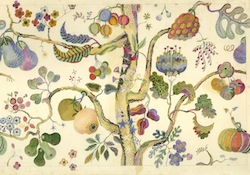By Charlene Kahn, Special to JTNews
A characteristic of timeless design is the ability for a piece to reappear as if newly imagined, seamlessly melding its actual origins with the contemporary viewer and resisting categorization. An accurately titled local exhibit, “The Enduring Designs of Josef Frank,” on view at The Nordic Heritage Museum in Ballard, left this viewer visually delighted. Frank’s name is known to interior designers and the home furnishings trade in his adopted country of Sweden and in Austria, his country of origin. More than 30 years of his career were spent collaborating with Estrid Ericson, founder of the Swedish design house Svenskt Tenn, which also funded the travelling exhibit.
“This exhibit is a wonderful opportunity to explore the work of this groundbreaking Jewish designer, who fled Vienna before the Second World War and came to define Swedish modernism,” Nordic Heritage Museum CEO Eric Nelson told me. “The core mission of the Nordic Heritage Museum is to share Nordic culture with a broad audience.
The exhibit pays homage to the works created during the second half of Josef Frank’s long-running career. Frank was born in 1885 and died at 82 in 1967.
All works shown in the exhibit were designed during in the 1920s through the 1940s, but produced in 2010. The revival of Frank’s Swedish Modern style as a standard of contemporary design has experienced a resurgence since the 1980s. While the term “modern design” is often eponymous with cold, sterile severity, Frank emphasized comfort and informality, producing whimsical designs inspired by nature.
Frank’s non-Jewish wife, Anna Sebelius, kept Frank one step ahead of the Nazis, moving them from Vienna to Stockholm in 1933 and from Stockholm to New York City in 1942, when Sweden became occupied. In 1946, the Franks returned to Sweden, where he remained principal designer at Svenskt Tenn.
The Seattle exhibit, at once modern yet cozy, provides the visitor an easy amble through hanging bolts of colorful fabric, clean-lined wooden cabinetry, well-cushioned upholstery, and tactile, cast glass. Sinuously designed silver candleholders called “The Knot of Friendship” are positioned by the entry. The bright, curving upholstery of the “Banana” sofa welcomes viewers, though that welcome is bit of a tease with the “Do Not Touch” sign affixed to it.
Everything is warmth, color, comfort: A multi-colored floor lamp beckons the child within. There is nothing austere about these luscious patterns and well-appointed furnishings, effective antidotes to the cold rains of Stockholm — and Seattle.
“A home…must offer comfort, rest and a nice atmosphere where the eye can rest, and the mind be refreshed,” wrote Frank in 1931.
Frank’s brief stay in America produced botanically inspired textile designs still popular today. Created during the 1940s, the source for “US Tree” was a field manual; the origin of the cheerful “Green Birds” was a sourcebook. Both are included in the exhibit. Frank’s dedication and artistic single-mindedness probably contributed to his survival; his reputation as a skilled designer brought him to the notice of Svenskt Tenn’s founder Estrid Ericson; using nature as a primary inspiration helped Frank cope with his dislocated refugee’s experience. Relocating mid-career, Frank was 55 when he arrived in Manhattan.
Visitors might do well to purchase an inexpensive ($15) catalog from a 2007 retrospective of Frank’s life and art by the Jewish Museum of Stockholm, available at this museum’s gift shop. And what would a colorful design exhibit be without the opportunity to purchase your own Frank merchandise? Smaller items range from cocktail napkins, paper cubes and notecards up to more pricey fabric pillows, totes and serving trays.
The Nordic Heritage Museum represents the cultural heritage of five Nordic countries: Denmark, Finland, Iceland, Norway and Sweden. Housed in a renovated former public school, the inscription of Webster School is still visible above the entry of the square-block—sized 1907 dark brick building. Free parking is available in a parking lot in front of the museum; the entry and exhibition spaces are walker and wheelchair-accessible. During both of my visits last month, the facility museum was nicely heated; art exhibition spaces are often uncomfortably cool, a detracting factor for the older visitor.
